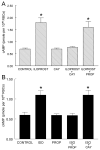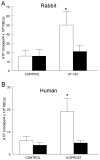Prostacyclin analogs stimulate receptor-mediated cAMP synthesis and ATP release from rabbit and human erythrocytes
- PMID: 18574748
- PMCID: PMC3076303
- DOI: 10.1080/10739680701833804
Prostacyclin analogs stimulate receptor-mediated cAMP synthesis and ATP release from rabbit and human erythrocytes
Abstract
Objectives: The purpose of this study was to establish that the prostacyclin (PGI(2)) receptor (IP receptor) is present on rabbit and human erythrocytes and that its activation stimulates cyclic adenosine monophosphate (cAMP) synthesis and adenosine triphosphate (ATP) release.
Methods: The effect of incubation of erythrocytes with the active PGI(2) analogs, iloprost or UT-15C, on cAMP levels and ATP release was determined in the absence and presence of the IP receptor antagonist, CAY10441. Western analysis was used to determine the presence of the IP receptor on isolated membranes. To establish that effects of PGI(2) analogs were not due to prostaglandin E(2)(PGE(2)) receptor activation, the effect of PGE(2) on cAMP levels and ATP release was determined.
Results: Rabbit and human erythrocytes possess IP receptors. Iloprost and UT-15C stimulated increases in cAMP and ATP release that were prevented by the IP receptor antagonist, CAY10441. PGE(2) did not stimulate cAMP accumulation or ATP release and did not inhibit iloprost-induced increases in cAMP.
Conclusions: This study establishes that the IP receptor is present on rabbit and human erythrocytes and that its activation results in increases in cAMP and ATP release. These results suggest a novel mechanism by which PGI(2) and its active analogs, when administered pharmacologically, could produce vasodilation.
Figures







References
-
- Aronoff D, Peres C, Serezani C, Ballinger M, Carstens J, Coleman N, Moore B, Peebles R, Faccioli L, Peters-Golden Synthetic prostacyclin analogues differentially regulate macrophage function via distinct analog-receptor binding specificities. J Immonol. 2007;178:1628–1634. - PubMed
-
- Barst R, Rubin L, McGoon M, Caldwell E, Long W, Levy P. Survival in primary pulmonary hypertension with long-term continuous intravenous prostacyclin. Ann Intern Med. 1994;121:409–415. - PubMed
-
- Bergfeld G, Forrester T. Release of ATP from human erythrocytes in response to a brief period of hypoxia and hypercapnea. Cardiovasc Res. 1992;26:40–47. - PubMed
-
- Collins D, McCullough W, Ellsworth M. Conducted vascular responses: Communication across the capillary bed. Microvas Res. 1998;56:43–53. - PubMed
Publication types
MeSH terms
Substances
Grants and funding
LinkOut - more resources
Full Text Sources
Other Literature Sources
Medical

